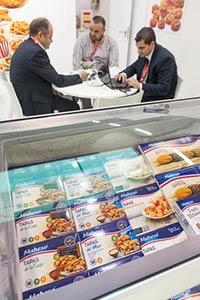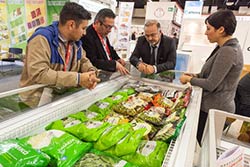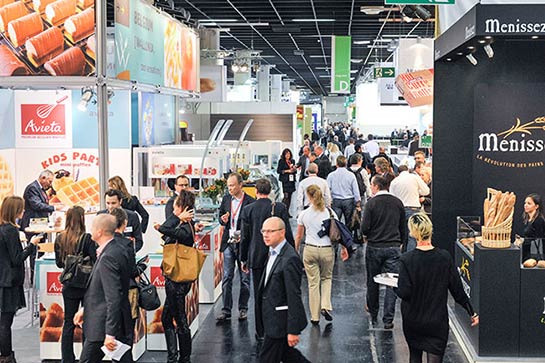The clock seems to be ticking faster right about now for exhibitors, buyers, sellers and visitors going to the Anuga Frozen Food fair, which kicks off on October 10 in Cologne, Germany. Held every two years in the city along the Rhine River, the five-day extravaganza offers a concentrated commercial platform for international frozen food players to conduct business at the world’s largest trade event – which is presented as “10 trade shows in one” – for the all-encompassing F&B industry.

On each day doors will open for visitors at 10 AM and close at 6 PM. The fairgrounds will be accessible to exhibitors from 9 AM to 7 PM. Those in need of admission tickets may still make purchases online by visiting: www.anuga.com/anuga/for-visitors/Admission-ticket/index.php.
Gathered in Frozen Food Halls 4.1 and 4.2 at the sprawling Koelnmesse complex will be over 500 exhibitors from approximately 50 countries presenting a wide range of products. They will be among more than 7,000 companies from 108 nations showcasing goods and services across an area of 280,000-plus square meters of exhibition space.
 Among frozen food manufacturers exhibiting in Hall 4 and elsewhere will be: Ardo, Brasil Foods, Lutosa, Pinguin/Greenyard Foods, Givrex, Salomon FoodWorld, MEX-Al El Sombrero Import-Export, Scelta Mushrooms, Agrarfrost, Agristo, Almondy, Aviko, Crop’s, Charoen Pokphand Foods, Thai Union, Clarebout Potatoes, D’Arta, Ecofrost, Herbafrost, Horafrost, Galana, Gunnar Dafgard, Erlenbacher, Farm Frites, Lamb Weston, Keck Spezialitaten, Vossko, Maheso, Mydibel, Miratorg, Pasfrost, Pickenpack, Roncadin, Surgital, Westfro, Wernsing and YSCO.
Among frozen food manufacturers exhibiting in Hall 4 and elsewhere will be: Ardo, Brasil Foods, Lutosa, Pinguin/Greenyard Foods, Givrex, Salomon FoodWorld, MEX-Al El Sombrero Import-Export, Scelta Mushrooms, Agrarfrost, Agristo, Almondy, Aviko, Crop’s, Charoen Pokphand Foods, Thai Union, Clarebout Potatoes, D’Arta, Ecofrost, Herbafrost, Horafrost, Galana, Gunnar Dafgard, Erlenbacher, Farm Frites, Lamb Weston, Keck Spezialitaten, Vossko, Maheso, Mydibel, Miratorg, Pasfrost, Pickenpack, Roncadin, Surgital, Westfro, Wernsing and YSCO.
Elsewhere on the premises, companies holding forth at national pavilions from countries including Egypt, Belgium, China, France, Italy, the Netherlands, Poland, Portugal and Spain will be demonstrating competence in frozen foods with their respective focuses on fish, red meat, poultry, fruit, vegetables, baked goods, ready meals and ice cream for the retail, foodservice and industrial sectors.
Frozen Food History Marches On This year marks the 80th anniversary of the industrial frozen food industry, which was officially born on March 6, 1935, when the first deep freezer merchandising case was stocked with vegetables, fruit and fish at a retail shop in Springfield, Massachusetts, USA. The subsequent worldwide success story of frozen products led American President Ronald Reagan to inaugurate “Frozen Food Day” almost half a century later in 1984. The birthday has been celebrated annually on March 6 ever since, and National Frozen Food Month is promoted by the trade throughout March in the United States.
This year marks the 80th anniversary of the industrial frozen food industry, which was officially born on March 6, 1935, when the first deep freezer merchandising case was stocked with vegetables, fruit and fish at a retail shop in Springfield, Massachusetts, USA. The subsequent worldwide success story of frozen products led American President Ronald Reagan to inaugurate “Frozen Food Day” almost half a century later in 1984. The birthday has been celebrated annually on March 6 ever since, and National Frozen Food Month is promoted by the trade throughout March in the United States.
The German frozen food industry made its Anuga debut in 1955 when six domestic companies presented products in retail packaging for the first time. Thereafter the demand for frozen fare has steadily increased in Germany, especially after home freezers became popular among consumers. By 1970, per capita consumption of frozens had reached ten kilograms a year in the Federal Republic.
The appetite among Germans for frozen food fare has been unabated until this day. According to a recent survey, 90% of people in Germany say that frozen products not only simplify home storage of food, but also make cooking far easier. In total, the value of frozen product sales in Germany was approximately €12.8 billion in 2014, up 3% over the previous year. Today, the national trade offers consumers over 17,000 different frozen items and per capita consumption has topped 42 kilograms.
Market Opportunities Far and Wide
The frozen food industry has enormous potential to expand worldwide. However, not every country has the same growth opportunities.
While the United States remains the undisputed world champion in terms of consumption of frozen food with annual per capita intake of 52 kilograms, this figure has been relatively stagnant for a number of years. As such, the best growth prospects are now in Eastern Europe, Asia and other regions where economies are developing and the living standards are rising.
 Special products for consumers with specific food intolerances or allergies also offer market opportunities. According to a survey conducted by the German Celiac Association (DZG) in collaboration with Swedish frozen baked goods supplier Almondy, the market for gluten-free sweets in retail outlets has risen dramatically. This has been driven in particular by consumers coping with the symptoms of celiac disease.
Special products for consumers with specific food intolerances or allergies also offer market opportunities. According to a survey conducted by the German Celiac Association (DZG) in collaboration with Swedish frozen baked goods supplier Almondy, the market for gluten-free sweets in retail outlets has risen dramatically. This has been driven in particular by consumers coping with the symptoms of celiac disease.
The bakery segment, a huge part of the frozen food industry, continues to rise along with global appetites for rolls, cakes and tarts, while breakfast business and high demand for in-between meal snacks further boosts sales. One of the most popular frozen commodities is still pizza, which recorded strong growth in the away-from-home market last year.
The triumphant march of frozen food is continuing to be dynamic in the away-from-home market, where volume has increased by 4% to approximately 1.67 million tons. Whether in the catering or classic foodservice sector, in the travel and leisure time food channels, at school feeding satellite kitchens, retirement homes and hospitals, frozen food is an indispensable, fixed element among professional chefs and cooks at all levels.
In the retail food trade, slight growth was recorded last year throughout the industrial world for ready-to-serve meals, which primarily derives from the partial dishes segment. The complete meals and stews sector, on the other hand, experienced slight losses.
The trend is moving away from individual cooking toward utilizing solutions that provide one with a quick, uncomplicated, flexible and healthy diet. The lineup of frozen products thus becomes increasingly more diversified. Smaller retail packaging is demanded in the Western world, which is a result of the demographic change toward an increase in single and two-person households. On the foodservice front, buyers are increasingly relying on pre-portioned and ready-prepared components.






